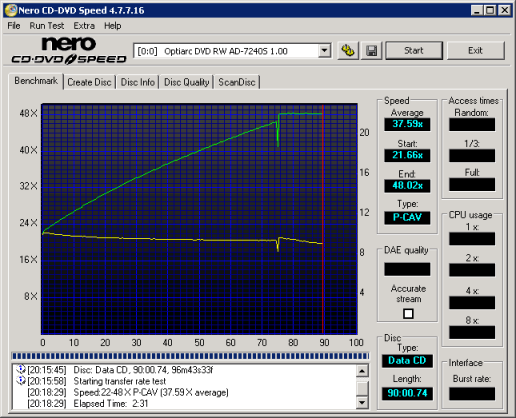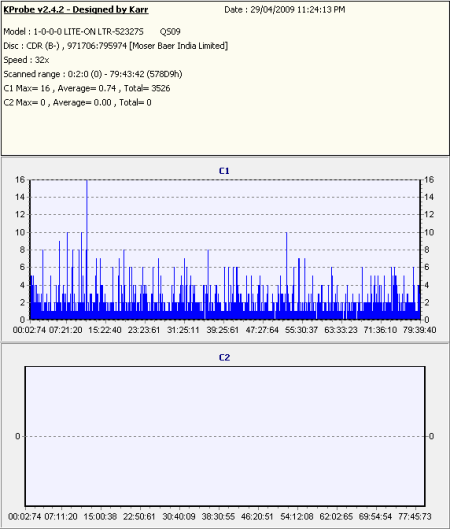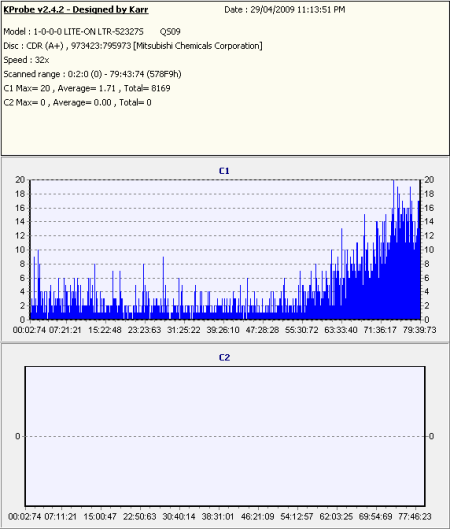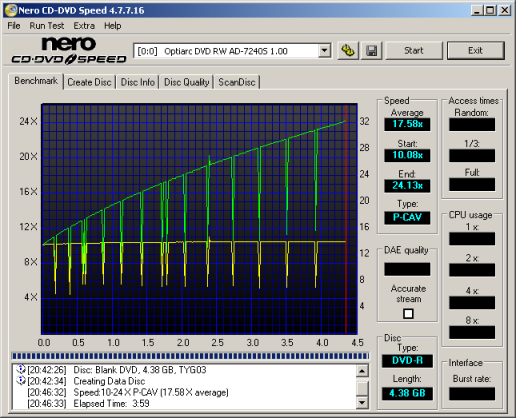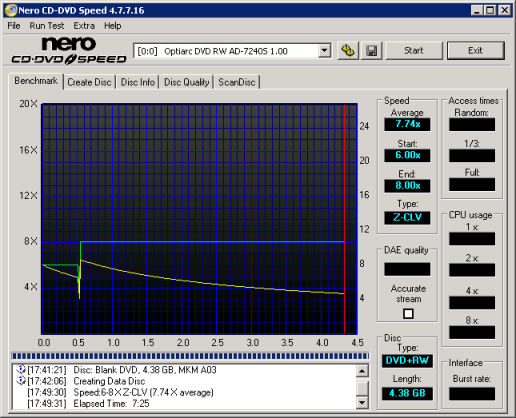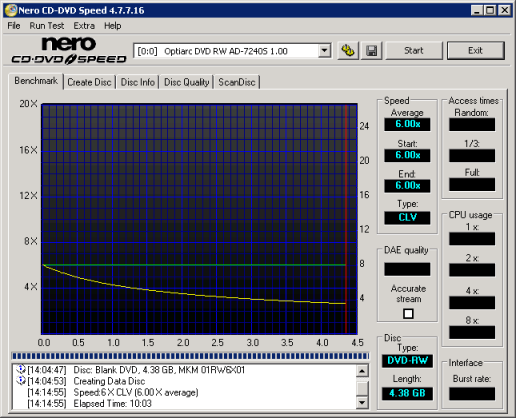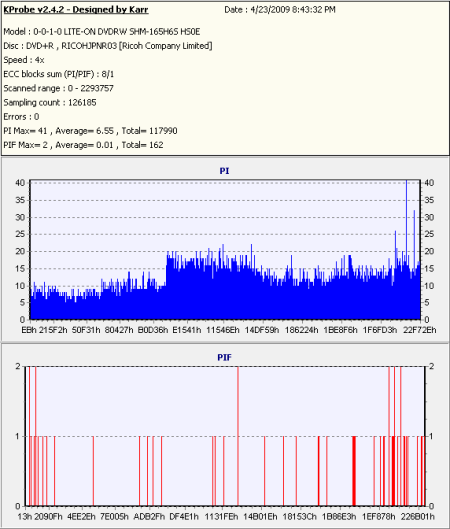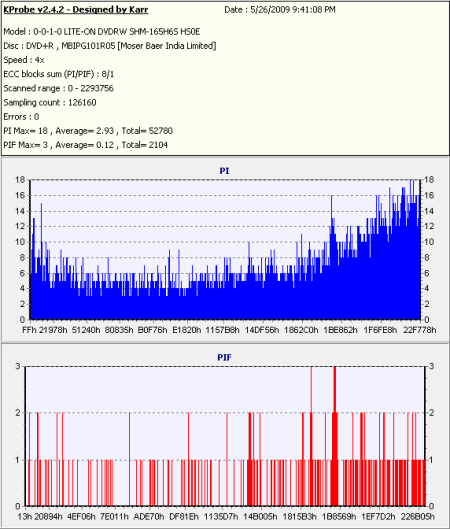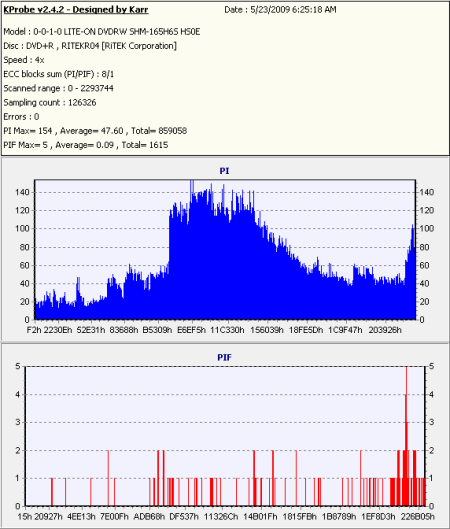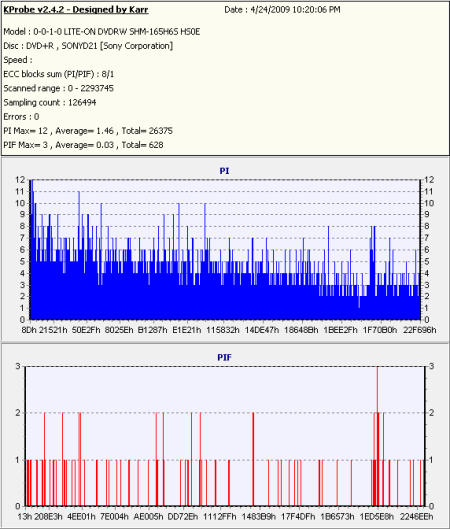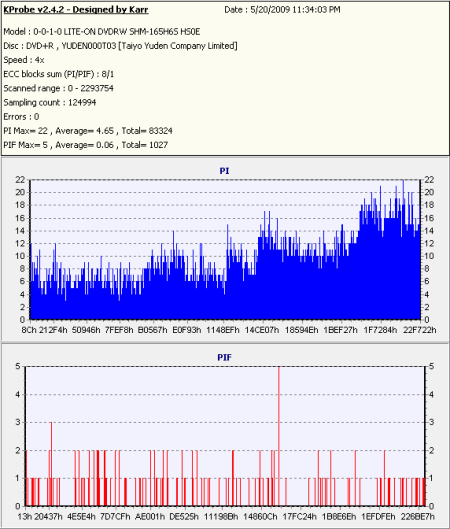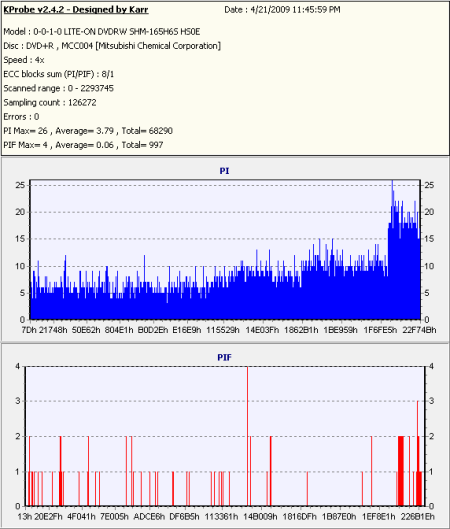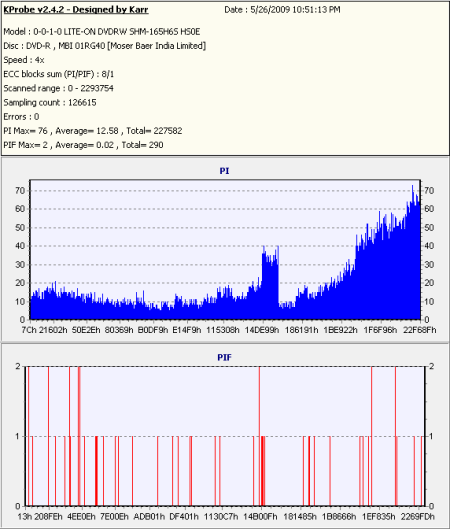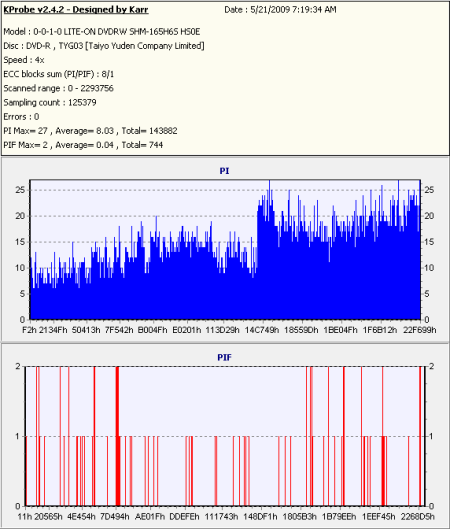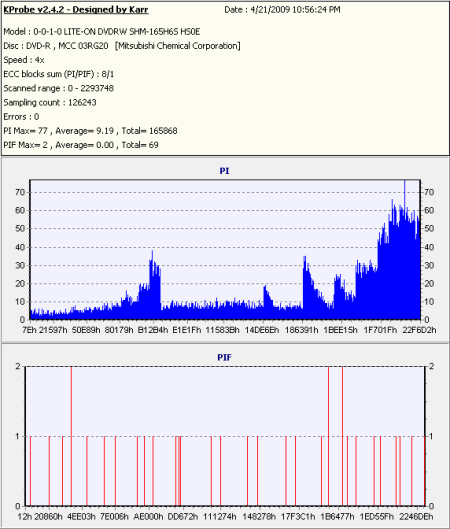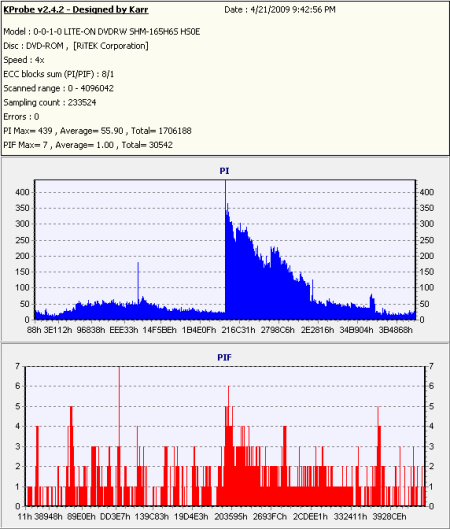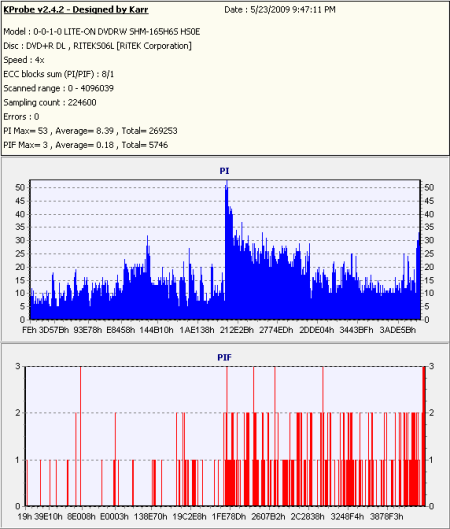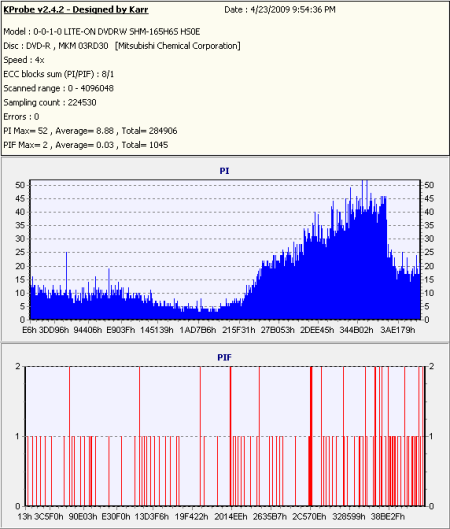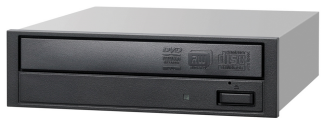
Model: Sony Optiarc AD-7240S 24x DVD±RW/RAM
Manufacturer: Sony Optiarc
Provided By: Sony Optiarc America
While a relatively new name in the optical storage industry, Sony Optiarc already has a lot of experience under its belt. Established in 2006 as a joint venture between Sony and NEC, Optiarc combines the technologies and expertise of its parent companies with the goal to provide the best optical drives in the world. It has definitely paid off, as Optiarc is quickly becoming one of the industry's largest manufacturers with a product lineup that includes DVD and Blu-ray Disc drives for the portable and desktop markets.
 While Blu-ray is slowly gaining momentum, the DVD still has a lot of life left in it. Companies like Optiarc continue to push the limits of the format, developing drives with new features and faster DVD writing speeds. This spring, Optiarc introduced one of the world's first 24x DVD writers, the AD-7240S. This Serial ATA equipped "Super-Multi" drive is capable of 24x DVD±R, 12x DVD±R DL, 8x DVD+RW, 6x DVD-RW and 12x DVD-RAM writing speeds and a maximum DVD read speed of 16x. The AD-7240S also includes features like 48x CD reading and writing speeds, 32x rewriting speeds and support for buffer underrun protection.
While Blu-ray is slowly gaining momentum, the DVD still has a lot of life left in it. Companies like Optiarc continue to push the limits of the format, developing drives with new features and faster DVD writing speeds. This spring, Optiarc introduced one of the world's first 24x DVD writers, the AD-7240S. This Serial ATA equipped "Super-Multi" drive is capable of 24x DVD±R, 12x DVD±R DL, 8x DVD+RW, 6x DVD-RW and 12x DVD-RAM writing speeds and a maximum DVD read speed of 16x. The AD-7240S also includes features like 48x CD reading and writing speeds, 32x rewriting speeds and support for buffer underrun protection.
We've had the AD-7240S in the 'Labs for a few weeks now and have had the time to put it through its paces. To give you an idea of what to expect from Optiarc's new DVD writer, we'll take a look at its features and then see how it compares to some of the 22x DVD±RW drives from the competition. Does the AD-7240S have what it takes? Is it the fastest DVD writer around? Keep reading to find out.

The AD-7240S we received from Sony Optiarc was an OEM version. The drive did not come with any software, cables or even a printed manual.
Physical Features:
The drive Optiarc sent us for this review was manufactured in February of 2009 and had firmware 1.00. For this review we used firmware versions 1.00 and 1.01.
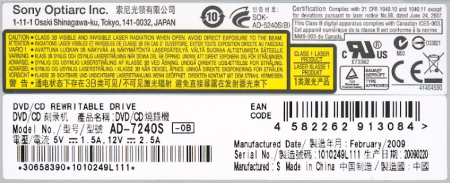
The look of Optiarc's drives really hasn't changed much over the last few years. While they've gotten new features and faster speeds, the basic design has remained the same. The AD-7240S is no exception. From the front, it's almost identical to Optiarc's previous DVD writers, sharing not only the bezel design, but many of the same logos. Along the front of the tray you can see a few showing support for Ultra Speed CD-RW media and the DVD+ReWritable and DVD Multi specifications.

Below the tray you can see the AD-7240S's single LED. Off by default, this LED lights up green when the drive is reading or writing.
The rear of the AD-7240S is fairly straight forward. By looking at the picture below you can see the drive's SATA interface and power connector.

Technical Specs:
The specs below have been taken from Sony Optiarc America's website and by running a few simple tests.
| Sony Optiarc AD-7240S 24x DVD±RW/RAM |
|
| DVD+R Write Speeds | 24x, 20x, 18x, 16x, 12x (CAV) 12x, 8x (Z-CLV) 6x, 4x, 2.4x (CLV) |
| DVD+RW Write Speeds | 8x (Z-CLV) 6x, 4x, 2.4x (CLV) |
| DVD-R Write Speeds | 24x, 20x, 18x, 16x, 12x (CAV) 12x, 8x (Z-CLV) 6x, 4x, 2x (CLV) |
| DVD-RW Write Speeds | 6x, 4x, 2x, 1x (CLV) |
| DVD+R DL Write Speeds | 12x (CAV) 8x, 6x (Z-CLV) 4x, 2.4x (CLV) |
| DVD-R DL Write Speeds | 12x (CAV) 8x, 6x (Z-CLV) 4x, 2x (CLV) |
| DVD-RAM Write Speeds | 12x (P-CAV) 5x, 3x, 2x (CLV) |
| CD Write Speeds | 48x, 40x (CAV) 32x, 24x (P-CAV) 16x, 8x (CLV) |
| CD Rewrite Speeds | 32x, 24x (Z-CLV) 16x, 10x, 4x (CLV) |
| DVD Read Speeds | 16x Max (DVD-ROM Single Layer) 12x Max (DVD-ROM Dual Layer) 16x Max (DVD±R) 13x Max (DVD±RW) 12x Max (DVD±R DL) 12x Max (DVD-RAM) |
| CD Read Speeds | 48x Max (CD-ROM/CD-R) 40x Max (CD-RW) |
| DAE Speed | 40x Max |
| Buffer Size | 2 MB |
| Random Access Times |
140 ms (CD) 160 ms (DVD) 210 ms (DVD-RAM) |
| CD Formats | CD-DA CD-ROM CD-ROM XA CD-R CD-RW CD-Extra CD-I Photo CD Video CD CD Text |
| DVD Formats | DVD-ROM DVD-R/RW DVD+R/RW DVD+R DL DVD-R DL DVD-RAM |
| CD Recording Modes | Track At Once Session At Once Disc At Once Fixed And Variable Packet Writing |
| DVD+R Recording Modes | Disc At Once Sequential Recording |
| DVD+RW Recording Mode | Disc At Once Random Write Sequential Recording |
| DVD-R Recording Modes | Disc At Once Incremental Recording Multi-Border |
| DVD-RW Recording Modes | Disc At Once Incremental Recording Multi-Border Restricted Overwrite |
| DVD-RAM Recording Mode | Random Write Sequential Recording |
More Features:
By looking at the picture below, you can see that Optiarc's new DVD writer is identified as an "Optiarc DVD RW AD-7240S."

Nero shows that the AD-7240S has a maximum CD writing speed of 48x and a 2048KB buffer, which is backed up by some form of buffer underrun protection. According to Nero, the drive can also write CD-Text and overburn. Unfortunately, like Optiarc's earlier DVD writers, it wasn't able to recognize our 99 minute CompUSA discs at all.
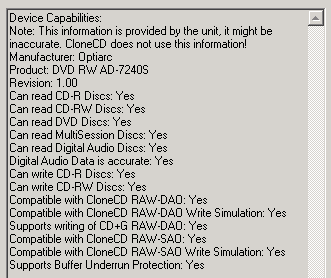
Using Alex Noe's Weak Sector Utility I was able to determine that the AD-7240S is a "two sheep" burner. This means that Optiarc's new drive is capable of backing up titles protected by SafeDisc 2, including version 2.51.
Here is a screen shot from Nero's InfoTool. This program queries the drive to see what its reading and writing capabilities are. InfoTool had no problems detecting the AD-7240S's maximum reading and writing speeds, recording modes, buffer underrun protection and 2MB buffer.
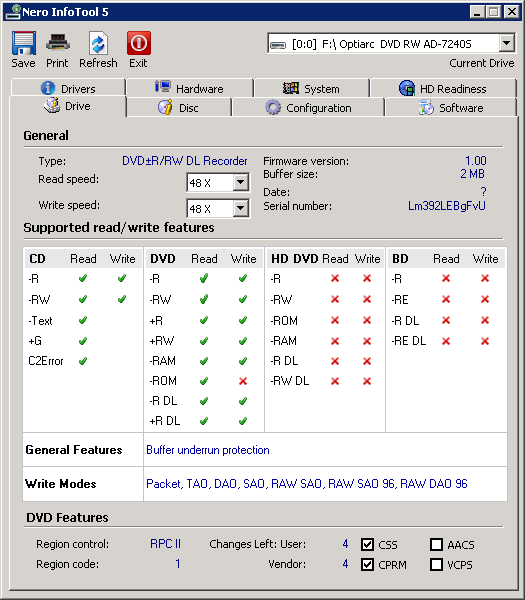
InfoTool also shows that the AD-7240S is an RPC-2 DVD drive. This means that the drive's region is stored in the firmware. The region can be changed five times and after that it cannot be changed anymore. A patched RPC-1 firmware can be downloaded here. Just keep in mind that it is not supported by Optiarc nor by CDRLabs. Use it at your own risk.

While InfoTool gives us a quick glance at the AD-7240S's features, DVDINFOpro provides a little more information on some of the drive's reading and writing capabilities. By looking at the screenshot above you can see Optiarc's new drive can read and write to DVD+R DL, DVD-R DL and DVD-RAM media, it does not support technologies like LightScribe or Labelflash. If you need a drive that supports these technologies, they are supported on Optiarc's other 24x DVD writers, the AD-7241S (LightScribe) and AD-7243S (LabelFlash).

The AD-7240S doesn't let you set the book type of single layer DVD+R or DVD+RW media. However, using software like Nero, you can set the book type for DVD+R DL discs to "DVD-ROM." This greatly reduces compatibility problems, especially with older DVD players.
While affordably priced, the Sony Optiarc AD-7240S delivers a good number of features. This Serial ATA equipped "Super Multi" drive not only supports all major DVD formats, it sports some of the fastest DVD reading and writing speeds available. The AD-7240S is capable of 24x DVD±R, 12x DVD±R DL, 8x DVD+RW, 6x DVD-RW and 12x DVD-RAM writing speeds and a maximum DVD read speed of 16x. Optiarc's new drive also includes features like a 2MB buffer and support for some sort of buffer underrun protection, but lacks bitsetting support for single layer DVD+R and DVD+RW media. Even then, the Sony Optiarc AD-7240S scores a solid 8 out of 10 for its features.
Along with smaller cable size, one of the biggest benefits of Serial ATA is its ease of installation. Because it uses a point to point connection, setting jumpers has become a thing of the past. In most cases, installation is as simple as plugging in the SATA and power cables and turning the computer on. Needless to say, it took only a couple of minutes to install Optiarc's DVD writer in our test computer. After making sure that the AD-7240S was recognized by Windows, I was ready to go.
Documentation:
As I mentioned earlier, the drive we received from Optiarc did not come with any software or documentation. Fortunately, I was able to download a copy of the operating instructions from Optiarc's website. Similar to the ones included with NEC's earlier drives, this manual covers a number of different topics. It starts out by going over the various buttons and connectors located on the front and back of the AD-7240S. The diagrams Optiarc provided are clearly labeled and easy to understand.
From here, the manual jumps right into the installation process. With no jumpers to configure, this section is relatively brief. Nevertheless, it covers all of the basics including how to install the drive in your computer and hook up the cables. The manual also has a brief section on how to use the AD-7240S. It explains how to insert and eject DVD's and how to get a disc out of the drive in case of an emergency. Last but not least, the manual finishes up with a comprehensive list of specifications for the AD-7240S.
Like Optiarc's previous DVD writers, the AD-7240S was very easy to install. Even with the basic manual I had, there were no problems getting the drive up and running. Just keep in mind that like with any OEM drive, it's up to the vendor as to whether or not you will receive any documentation or software. Overall, I give the installation an 8 out of a possible 10.
While CPU, memory, OS and other variables don't often make a huge difference, there are some nonetheless. We have a computer that is used only for testing hardware. We do this so all tests can be compared reliably.
Test System:
| CPU: | AMD Athlon 64 X2 4600+ 2.4GHz | |
| Motherboard: | ASUS M2N-SLI Deluxe with BIOS 0304 | |
| Memory: | Corsair TWIN2X2048-6400 | |
| Video Card: | MSI NX7900GT-T2D256E - ForceWare v93.71 | |
| Hard Drive: | Seagate Barracuda 7200.10 SATA 3.0Gb/s 320GB | |
| Operating System: | Windows XP SP2 - NVIDIA nForce v9.16 |
For DVD writers the performance tests are broken down into four sections: CD read, CD write, DVD read and DVD write tests. Each benchmark test has been run three times. The score given is an average of the three. DMA has been enabled in device manager for all IDE devices supporting it.
CD Read Tests: For the read performance section of the CD-ROM benchmarks, CD WinBench 99 and CD Speed are used to test transfer speeds, seek times and CPU usage. For DAE testing, CD Speed is used to give an overall speed rating and is used in combination with CD DAE to see how well a drive reads scratched and dirty discs.
CD Write Tests: To test the write speeds, Nero Burning Rom is used to write 700MB to our test media. Times are recorded. To test rewrite scores, Nero is used again to time how long it takes to write 400MB of random files and directories. Then Sonic's DLA is used to test packet writing speeds. The same files are copied and pasted in Windows Explorer and timed.
DVD Read Tests: For the read performance section of the DVD benchmarks, CD Speed is used to test read speeds, seek times, and CPU usage.
DVD Write Tests: To test the DVD write speeds, Nero Burning Rom is used to write 4GB to our test media. Times are recorded. Then Sonic's DLA is used to test packet writing speeds. The same files are copied and pasted in Windows Explorer and timed.
CD Winbench 99 Scores:
| Optiarc AD-7240S |
Samsung SH-S223Q |
LG GH22LP20 |
Optiarc AD-7200S |
|
| CD Winbench 99 | 1575 KB/sec | 2160 KB/sec | 2047 KB/sec | 1695 KB/sec |
| Transfer Rate: Inside | 2780 KB/sec | 3070 KB/sec | 3170 KB/sec | 2800 KB/sec |
| Transfer Rate: Outside | 6360 KB/sec | 6450 KB/sec | 6470 KB/sec | 6370 KB/sec |
| Random Access Time | 146ms | 87ms | 93ms | 130ms |
| CPU Utilization | 1.97% | 3.54% | 4.27% | 2.22% |
The CD Winbench test is as close as we can get to testing every day usage. It fires off eight different applications using scripts. This tries to mimic the activities of a person loading these programs onto their own computer.
Optiarc's new DVD writer gave us some mixed performance in our CD Winbench tests. While the AD-7200S's overall score wasn't as high as some of the other drives, its transfer rates were fairly good. It started reading at 18.5x (2780 / 150) and reached a maximum speed of about 42.4x (6370 / 150) on the outside.
CD Speed v4.7.7.16 - Pressed CD:
For this test I used a pressed CD containing one Mode 1 data track. The disc is 74:38 in size and is full of data and directories.
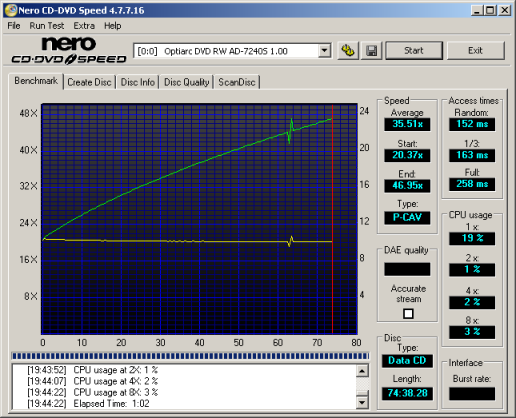
| Optiarc AD-7240S |
Samsung SH-S223Q |
LG GH22LP20 |
Optiarc AD-7200S |
|
| Transfer Speed Average: Start: End: |
35.51x 20.37x 46.95x |
35.98x 20.97x 47.60x |
35.59x 20.56x 47.15x |
35.50x 20.41x 46.96x |
| Seek Times Random: 1/3: Full: |
151ms 164ms 259ms |
101ms 106ms 176ms |
101ms 107ms 171ms |
143ms 157ms 236ms |
| CPU Usage 1x: 2x: 4x: 8x: |
19% 1% 2% 3% |
0% 1% 1% 3% |
0% 1% 2% 4% |
16% 1% 2% 4% |
The AD-7240S didn't perform as well as I had expected when reading pressed CD's. While rated at 48x, Optiarc's new drive came up a little short of this number in our tests. Looking at the other scores, its seek times were also a little higher than we'd like to see.
CD Speed v4.7.7.16 - CD-R Media:
For this test I made a copy of our pressed test CD. I used 12x rated Memorex Gold 74 minute media for the tests.

| Optiarc AD-7240S |
Samsung SH-S223Q |
LG GH22LP20 |
Optiarc AD-7200S |
|
| Transfer Speed Average: Start: End: |
36.26x 20.72x 48.04x |
31.31x 18.09x 41.48x |
36.36x 20.74x 48.20x |
36.25x 20.62x 48.01x |
| Seek Times Random: 1/3: Full: |
154ms 187ms 260ms |
97ms 106ms 174ms |
102ms 111ms 175ms |
143ms 169ms 243ms |
| CPU Usage 1x: 2x: 4x: 8x: |
20% 1% 2% 4% |
0% 1% 2% 4% |
0% 1% 2% 4% |
16% 1% 2% 4% |
The AD-7240S was a little faster when reading CD-R media. While this wasn't enough to top the drive from LG, it had no problems reaching a maximum transfer speed of 48x in our tests. Unfortunately, its seek times were again a little high.
Optiarc's new DVD writer had some trouble reading our 99 minute CompUSA media. If the session on the CD was larger than 90 minutes in size, the AD-7240S would not recognize the disc correctly. Using a disc with about 90 minutes worth of data, I was able to reach a maximum read speed of about 48.02x.
CD Speed v4.7.7.16 - CD-RW Media:
For this test I made a copy of a pressed test CD. I used some PNY 80 minute CD-RW media for the tests.

| Optiarc AD-7240S |
Samsung SH-S223Q |
LG GH22LP20 |
Optiarc AD-7200S |
|
| Transfer Speed Average: Start: End: |
30.72x 17.76x 40.01x |
30.76x 18.08x 40.63x |
31.25x 18.11x 41.29x |
30.71x 17.71x 40.00x |
| Seek Times Random: 1/3: Full: |
154ms 183ms 258ms |
97ms 102ms 175ms |
102ms 111ms 171ms |
144ms 155ms 239ms |
| CPU Usage 1x: 2x: 4x: 8x: |
13% 1% 2% 4% |
0% 1% 2% 3% |
0% 1% 2% 4% |
8% 1% 2% 3% |
While the AD-7240S can read pressed and CD-R media at 48x, its CD-RW read speeds are limited to only 40x. As you can see, the drive had no problems reaching this speed in our tests.
CD DAE and CD Speed v4.7.7.16 (DAE) - Pressed CD:
For this test I used Pure Funk. The CD is almost exactly 74 minutes. This helps to squeeze the maximum performance out of the CD.

Exact Audio Copy can tell us a lot about a drive's capabilities. Looking at the screenshot, you can see that the Optiarc AD-7240S supports accurate stream, caches audio data and has the ability to retrieve C2 error information from audio CD's.
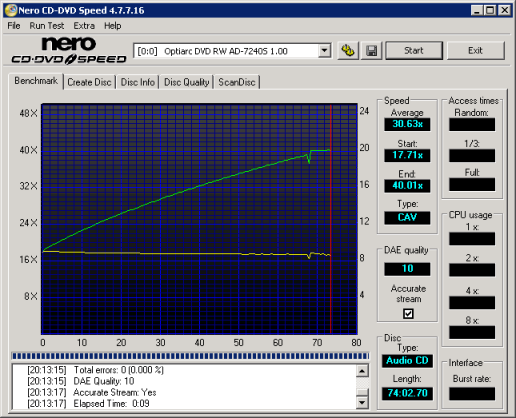
| CD Speed | Optiarc AD-7240S |
Samsung SH-S223Q |
LG GH22LP20 |
Optiarc AD-7200S |
| Average: Start: End: DAE Quality: Accurate Stream: |
30.63x 17.71x 40.01x 10 Yes |
30.66x 17.73x 40.44x 10 Yes |
31.44x 18.21x 41.56x 10 Yes |
30.89x 17.71x 40.00x 10 Yes |
The AD-7240S did fairly well in our DAE tests. While not nearly as fast as some of the other DVD writers we've tested, it had no problems ripping pressed audio CD's at 40x.
CD DAE and CD Speed v4.7.7.16 (DAE) - CD-R Media:
For this test I used a copy of the Pure Funk CD. It's burned onto the same Memorex Gold 74 minute media I used in the CD Speed tests.
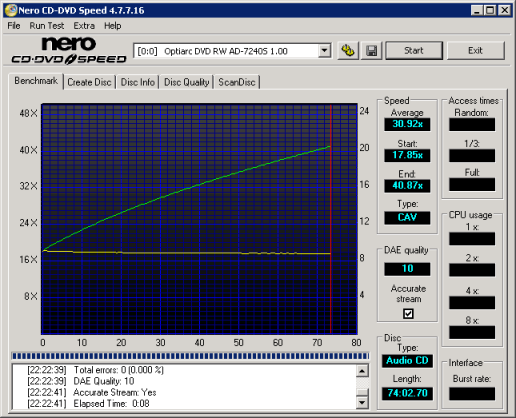
| CD Speed | Optiarc AD-7240S |
Samsung SH-S223Q |
LG GH22LP20 |
Optiarc AD-7200S |
| Average: Start: End: DAE Quality: Accurate Stream: |
30.92x 17.85x 40.87x 10 Yes |
30.94x 17.74x 40.90x 10 Yes |
31.15x 18.15x 41.04x 10 Yes |
30.62x 17.69x 40.01x 10 Yes |
The AD-7240S was slightly faster when ripping audio CD-R discs. Unfortunately, even with this increase in speed, it wasn't as fast as the LG GH22LP20. So how did it do in CD Speed's advanced DAE tests? Take a look below.
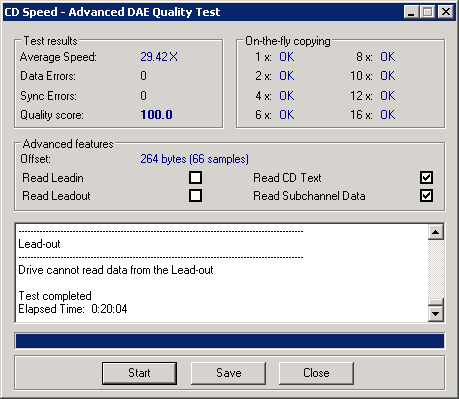
Optiarc's DVD writer completed CD Speed's advanced DAE tests with an average score of 29.42x. The drive had no problems passing all of the on-the-fly tests and did not create any errors. If you look at the advanced features, you can see that the AD-7240S was able to read the CD-Text and subchannel data but failed to read the lead in and lead out sections of the CD.
To see how well the AD-7240S can read scratched and dirty discs, I used CD Speed's ScanDisc utility to see how many sectors were damaged or unreadable. This is a very rough, but good way to test the drive's error correcting abilities.
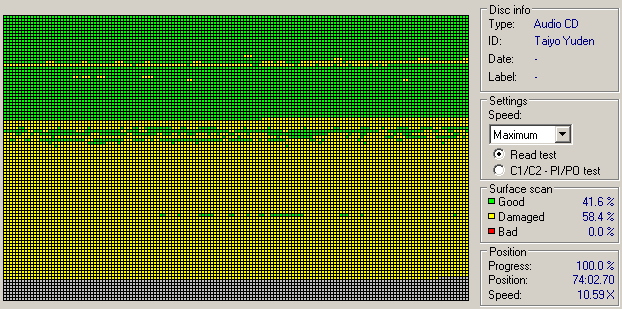
CD Speed - ScanDisc
The AD-7240S handled scratched discs relatively well. By looking at the screenshot, you can see that the drive considered only 58% of the CD to be "damaged". More importantly, none of the sectors on the disc were unreadable.
You can also get an idea of how well the drive can read scratched and dirty discs by using CD DAE. The application extracts the audio tracks twice and then compares them. From this information we can see what the drive's average speed was and how many errors it generated.
| CD DAE | Avg. Speed | Errors | % of Disc |
|
Optiarc AD-7240S |
11.6x | 2796031 | 0.36% |
|
Samsung SH-S223Q |
23.3x | 1332069 | 0.17% |
|
LG GH22LP20 |
28.2x | 613565 | 1.71% |
|
Pioneer DVR-116D |
25.3x | 99768247 | 12.73% |
The AD-7240S gave us some mixed results in this test. While the number of errors was very low, the scratches on the disc caused it to slow down considerably.
CD Write and ReWrite Tests - Nero Burning Rom 7.11.10.0 and DLA 5.20:
For this test I randomly generated 700MB of files and directories to test the time it takes the drive to write and close a CD. All of the files are between 1MB and 25MB in size and no more than 10 directories deep. All of the times below include not only the actual writing time, but the lead in and out times too. This gives a more realistic idea of how long it takes to write a CD.
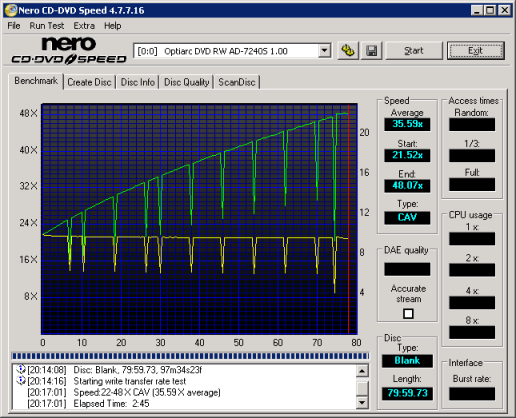
The AD-7200S has a maximum CD writing speed of 48x. To reach this speed, it uses CAV, or Constant Angular Velocity. With Verbatim's 52x media, the drive started writing at about 21.52x and reached a maximum speed of 48.07x at the end of the session. This gave Optiarc's new DVD±RW an average writing speed of about 35.59x.
To test the drive's writing times, I wrote our test data to some Verbatim media rated at 52x. The results are below.
| Size in MB | Size in Time | Optiarc AD-7240S |
Samsung SH-S223Q |
LG GH22LP20 |
Optiarc AD-7200S |
| 701MB | 79:44:21 | 2:58 | 2:50 | 2:41 | 3:12 |
While faster than the AD-7200S, the AD-7240S took longer than expected to complete our CD writing tests. In our tests, it trailed behind the drives from Samsung and LG, taking 2:58 to write an entire 701MB CD.
To test the drive's writing quality I used Lite-On IT's KProbe2. Written by Karr Wang, this utility can be used to test the number of C1 and C2 errors on a disc. For these tests I used a Lite-On LTR-52327S (firmware QS09) and read the discs at 32x.
The AD-7240S's writing quality was very good. By looking at the KProbe screenshots, you can see that the discs burned by the drive had a low number of C1 errors and there were no C2 errors at all.
For the rewriting tests I created 400MB of files on the hard drive and wrote them in DAO mode using Nero. To test the packet writing speeds I copied and pasted the same files off the hard drive onto a CD-RW disc using DLA from Sonic. Verbatim's 32x Ultra Speed CD-RW media was used for these tests.
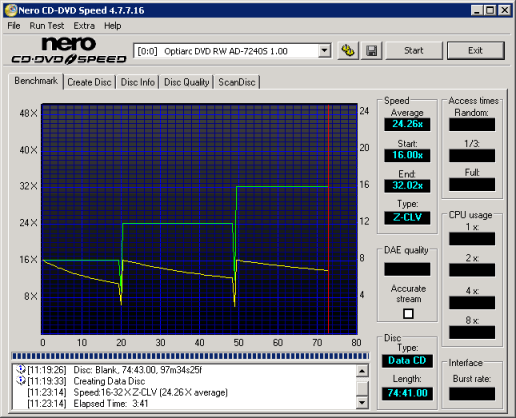
While the AD-7240S uses CAV when writing to CD-R discs, it uses Z-CLV, or Zone CLV, when rewriting at 32x. By looking at the screenshot above, you can see that it uses a total of three "zones" to reach its maximum speed. The drive starts writing at 16x and jumps to 24x at about the 20 minute mark. The AD-7240S writes at this speed until about the 49 minute mark. When it reaches this point, its writing speed increases to 32x and stays there until the end of the session.
| Software | Optiarc AD-7240S |
Samsung SH-S223Q |
LG GH22LP20 |
Optiarc AD-7200S |
| Nero | 2:43 | 2:23 | 2:42 | 2:11 |
| DLA Write | 2:42 | 3:31 | 2:34 | 2:17 |
| DLA Read | 1:38 | 1:44 | 1:37 | 1:36 |
Optiarc's new DVD writer didn't do as well as some of the other drives in our rewriting tests. Due to its Z-CLV writing method, the AD-7240S took 2:43 to write 400MB with Nero and 2:42 to do the same with DLA.
| Optiarc AD-7240S |
Samsung SH-S223Q |
LG GH22LP20 |
Optiarc AD-7200S |
|
| Quick Erase | 18 seconds | 18 seconds | 16 seconds | 16 seconds |
| Full Erase | 3:44 | 3:16 | 5:07 | 3:06 |
While the AD-7240S's Z-CLV writing method didn't have much of an affect on its quick erase time, it took 3:44 to do a full erase.
Nero CD Speed v4.7.7.16 - DVD-ROM:
For this test I used a single layer, single sided data DVD-ROM disc that is 4.37GB in size.
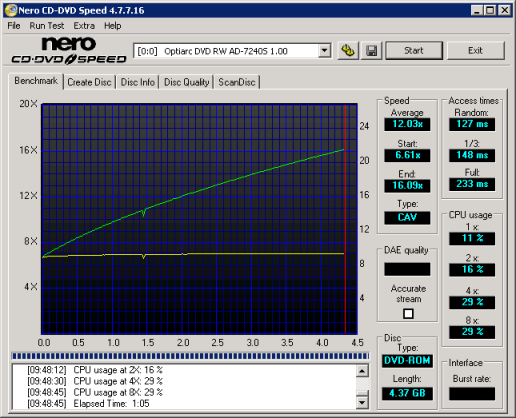
| Optiarc AD-7240S |
Samsung SH-S223Q |
LG GH22LP20 |
Optiarc AD-7200S |
|
| Transfer Speed Average: Start: End: |
12.03x 6.61x 16.09x |
12.13x 6.75x 16.21x |
12.00x 6.57x 16.05x |
12.03x 6.61x 16.09x |
| Seek Times Random: 1/3: Full: |
129ms 149ms 232ms |
96ms 110ms 188ms |
115ms 135ms 199ms |
124ms 141ms 226ms |
| CPU Usage 1x: 2x: 4x: 8x: |
11% 16% 29% 29% |
8% 5% 10% 19% |
4% 8% 15% 26% |
11% 9% 16% 29% |
The AD-7240S was fairly quick when reading single layer DVD-ROM's. In our tests it started reading at 6.61x and reached a maximum transfer speed of 16.09x. Unfortunately, its seek times were not as low as some of the other drives.
Nero CD Speed v4.7.7.16 - DVD-R, DVD-RW and DVD-RAM:
First, we'll look at the drive's DVD-R and DVD-RW reading performance. For this I made copies of our DVD-ROM test disc using some general use 8x DVD-R and 6x DVD-RW media from Verbatim and then ran our usual DVD read tests with CD Speed. For the DVD-RAM tests, media from Maxell was used. The results are below.

Verbatim DVD-R
| Optiarc AD-7240S |
Samsung SH-S223Q |
LG GH22LP20 |
Optiarc AD-7200S |
|
| Transfer Speed Average: Start: End: |
12.05x 6.63x 16.11x |
12.14x 6.74x 16.23x |
12.04x 6.59x 16.09x |
12.07x 6.62x 16.13x |
| Seek Times Random: 1/3: Full: |
129ms 166ms 253ms |
116ms 132ms 201ms |
123ms 154ms 242ms |
125ms 153ms 245ms |
| CPU Usage 1x: 2x: 4x: 8x: |
14% 17% 31% 32% |
10% 5% 11% 22% |
5% 9% 16% 28% |
13% 16% 24% 33% |
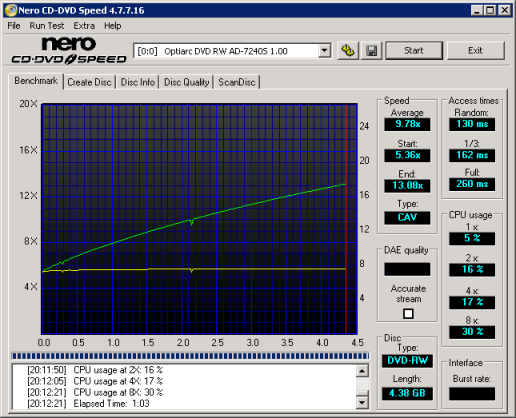
Verbatim DVD-RW
| Optiarc AD-7240S |
Samsung SH-S223Q |
LG GH22LP20 |
Optiarc AD-7200S |
|
| Transfer Speed Average: Start: End: |
9.78x 5.36x 13.08x |
9.18x 5.08x 12.27x |
9.12x 5.02x 12.19x |
9.78x 5.36x 13.07x |
| Seek Times Random: 1/3: Full: |
130ms 163ms 260ms |
124ms 138ms 207ms |
128ms 166ms 258ms |
123ms 156ms 252ms |
| CPU Usage 1x: 2x: 4x: 8x: |
5% 16% 17% 30% |
9% 5% 10% 19% |
5% 9% 17% 32% |
5% 10% 17% 30% |
The AD-7240S performed very well when reading DVD-R and DVD-RW media. In our tests, the drive read DVD-R discs at 16x and DVD-RW media at a respectable 13x.

Verbatim DVD-R DL
| Optiarc AD-7240S |
Samsung SH-S223Q |
LG GH22LP20 |
Optiarc AD-7200S |
|
| Transfer Speed Average: Start: End: |
9.01x 4.98x 12.00x |
9.41x 5.23x 12.54x |
9.19x 5.09x 12.25x |
8.91x 4.93x 11.87x |
| Seek Times Random: 1/3: Full: |
152ms 172ms 255ms |
126ms 133ms 211ms |
138ms 163ms 243ms |
142ms 164ms 253ms |
| CPU Usage 1x: 2x: 4x: |
4% 13% 14% |
12% 7% 13% |
5% 10% 16% |
5% 8% 14% |
Optiarc's new drive wasn't as fast when reading Verbatim's 4x DVD-R DL media. As you can see, the AD-7240S started reading at 4.98x and reached a maximum transfer speed of 12.00x.
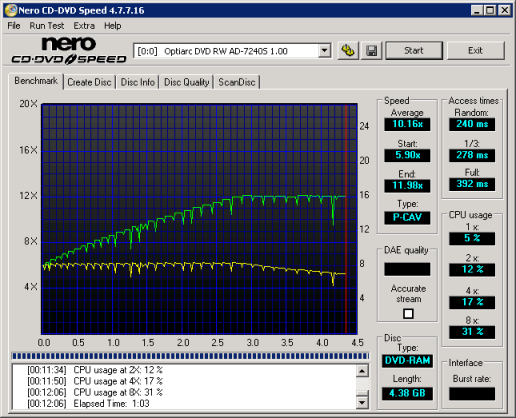
Maxell 12x DVD-RAM
| Optiarc AD-7240S |
Samsung SH-S223Q |
LG GH22LP20 |
Optiarc AD-7200S |
|
| Transfer Speed Average: Start: End: |
10.16x 5.90x 11.98x |
10.33x 5.95x 12.08x |
10.27x 5.92x 12.02x |
10.06x 5.91x 11.99x |
| Seek Times Random: 1/3: Full: |
243ms 276ms 392ms |
121ms 136ms 236ms |
180ms 169ms 243ms |
205ms 251ms 274ms |
| CPU Usage 1x: 2x: 4x: 8x: |
5% 12% 17% 31% |
8% 6% 10% 19% |
5% 9% 17% 35% |
13% 12% 18% n/a |
Optiarc's new drive has a maximum transfer speed of 12x when reading DVD-RAM discs. By looking at the screenshot you can see that it starts reading at 5.90x and accelerates, reaching 12x at the 2.9GB mark.
Nero CD Speed v4.7.7.16 - DVD+R and DVD+RW:
Next we'll look at the drive's DVD+R and DVD+RW reading performance. For this I made a copy of our DVD-ROM test disc using some 8x DVD+R and 8x DVD+RW media from Verbatim. I then ran our usual DVD read tests with CD Speed. The results are below.

Verbatim DVD+R
| Optiarc AD-7240S |
Samsung SH-S223Q |
LG GH22LP20 |
Optiarc AD-7200S |
|
| Transfer Speed Average: Start: End: |
12.06x 6.63x 16.12x |
12.15x 6.73x 16.24x |
12.03x 6.57x 16.08x |
12.06x 6.63x 16.12x |
| Seek Times Random: 1/3: Full: |
127ms 160ms 254ms |
117ms 131ms 205ms |
126ms 157ms 263ms |
124ms 150ms 246ms |
| CPU Usage 1x: 2x: 4x: 8x: |
12% 32% 18% 31% |
10% 6% 11% 23% |
5% 9% 15% 27% |
11% 10% 16% 29% |
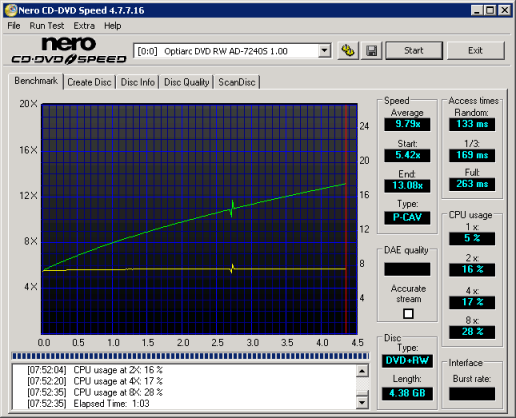
Verbatim DVD+RW
| Optiarc AD-7240S |
Samsung SH-S223Q |
LG GH22LP20 |
Optiarc AD-7200S |
|
| Transfer Speed Average: Start: End: |
9.79x 5.42x 13.08x |
9.19x 5.04x 12.28x |
9.13x 5.04x 12.20x |
9.79x 5.39x 13.08x |
| Seek Times Random: 1/3: Full: |
132ms 166ms 264ms |
125ms 134ms 198ms |
121ms 153ms 244ms |
123ms 153ms 248ms |
| CPU Usage 1x: 2x: 4x: 8x: |
5% 16% 17% 28% |
9% 5% 10% 19% |
5% 9% 16% 31% |
5% 9% 16% 29% |
The AD-7240S's performance with DVD+R and DVD+RW media was very similar to what we saw with DVD-R and DVD-RW media. The drive read DVD+R discs at 16x and DVD+RW media at 13x.
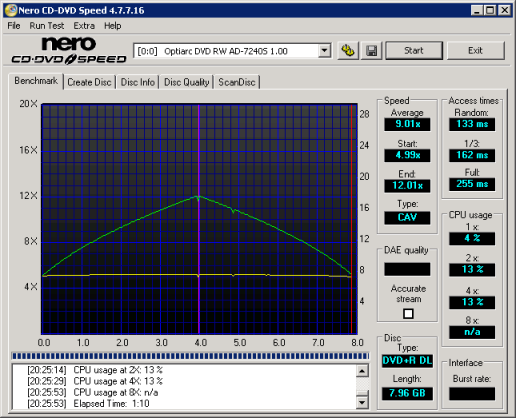
Verbatim DVD+R DL
| Optiarc AD-7240S |
Samsung SH-S223Q |
LG GH22LP20 |
Optiarc AD-7200S |
|
| Transfer Speed Average: Start: End: |
9.01x 4.99x 12.01x |
9.42x 5.23x 12.55x |
9.20x 5.09x 12.26x |
8.91x 4.93x 11.87x |
| Seek Times Random: 1/3: Full: |
133ms 164ms 255ms |
126ms 132ms 214ms |
135ms 172ms 246ms |
127ms 153ms 251ms |
| CPU Usage 1x: 2x: 4x: |
4% 13% 13% |
12% 7% 13% |
4% 9% 16% |
5% 7% 13% |
Reading Verbatim's double layer DVD+R media wasn't a problem for the AD-7240S either. The drive started reading at 4.99x and reached a maximum transfer speed of 12.01x.
Nero CD Speed v4.7.7.16 - DVD-Video:
For these tests I am using the US version of Transformers: The Movie on DVD. The disc is over 4GB and single sided.
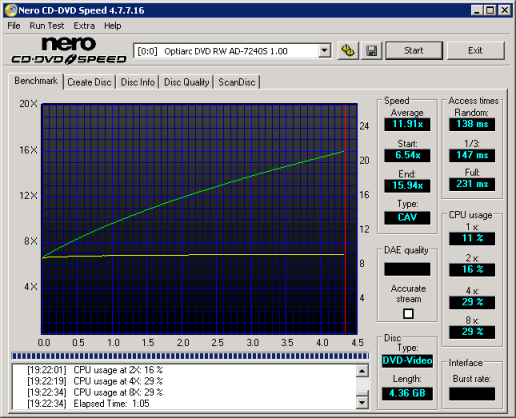
| Optiarc AD-7240S |
Samsung SH-S223Q |
LG GH22LP20 |
Optiarc AD-7200S |
|
| Transfer Speed Average: Start: End: |
11.91x 6.54x 15.94x |
12.00x 6.66x 16.05x |
4.50x 2.48x 6.01x |
11.91x 6.54x 15.93x |
| Seek Times Random: 1/3: Full: |
136ms 148ms 232ms |
97ms 114ms 186ms |
138ms 160ms 222ms |
123ms 146ms 225ms |
| CPU Usage 1x: 2x: 4x: 8x: |
11% 16% 29% 29% |
8% 6% 11% 21% |
5% 9% 16% n/a |
11% 9% 16% 29% |
The AD-7240S didn't slow down very much when reading single layer DVD videos. It started out at about 6.54x and reached a maximum read speed of 15.94x. Optiarc's new drive was also fairly quick when reading dual layer discs. By looking at the screenshot below, you can see that the drive's transfer speeds peaked at about 12x.

To see how well the AD-7240S worked as a DVD player, I watched a few scenes from Transformers: The Movie and Star Wars: Revenge of the Sith using Nero Showtime. The drive had no problems playing back these movies with either program and was fairly quiet.
DVD Write and ReWrite Tests - Nero Burning Rom 7.11.10.0 and DLA 5.20:
To test the DVD writing performance of Optiarc's new drive I used Taiyo Yuden 16x DVD+R, Taiyo Yuden 16x DVD-R, Verbatim 8x DVD+RW and Verbatim 6x DVD-RW media. To get the writing times, a 4.38GB image was burned to our test discs using Nero.
|
|
When writing to DVD+R and DVD-R media at 24x, the AD-7240S uses CAV. By looking at the screenshots above, you can see that Optiarc's new drive starts writing at about 10x and accelerates, reaching its maximum speed at the end of the disc.
The AD-7240S also features 8x DVD+RW and 6x DVD-RW writing speeds. While the drive uses CLV when writing to DVD-RW media, it uses Z-CLV to reach its maximum DVD+RW writing speed.
| Optiarc AD-7240S |
Samsung SH-S223Q |
LG GH22LP20 |
Optiarc AD-7200S |
|
| DVD+R | 4:18 | 4:39 | 4:30 | 4:57 |
| DVD-R | 4:06 | 4:28 | 4:22 | 4:38 |
| DVD+RW | 7:28 | 7:41 | 7:30 | 7:28 |
| DVD-RW | 10:00 | 10:03 | 10:22 | 10:05 |
Optiarc's new "Super-Multi" drive performed very well in our DVD writing tests. The AD-7240S turned in some of the fastest DVD±R and DVD±RW writing times we've seen, beating the drives from Samsung and LG by a small margin.
While Optiarc has a list of recommended media on its website, I wanted to see for myself how well the AD-7240S worked with some of the DVD+R and DVD-R discs available in my area. The media types, along with the average time it took the drive to write our 4.38GB image, are listed below.
| Manufacturer ID | Max Write Speed |
Average Write Time |
|
| Memorex 16x DVD+R | RICOHJPN R03 | 16x | 5:41 |
| Moser Baer 16x DVD+R | MBIPG101 R05 | 16x | 5:44 |
| RiDATA 16x DVD+R | RITEKR04 | 16x | 5:43 |
| Sony 16x DVD+R | SONYD21 | 18x | 5:14 |
| Taiyo Yuden 16x DVD+R | YUDEN000T03 | 24x | 4:18 |
| Verbatim 16x DVD+R | MCC-004 | 20x | 4:57 |
| Memorex 16x DVD-R | CMC MAG.AM3 | 16x | 5:35 |
| Moser Baer 16x DVD-R | MBI 01RG40 | 16x | 5:38 |
| RiDATA 16x DVD-R | RITEKF1 | 16x | 5:35 |
| Sony 16x DVD-R | SONY16D1 | 18x | 5:07 |
| Taiyo Yuden 16x DVD-R | TYG03 | 24x | 4:06 |
| Verbatim 16x DVD-R | MCC 03RG20 | 20x | 4:42 |
So what about writing quality? Thanks to KProbe, we can test a disc's PI (Parity Inner) and PIF (Parity Inner Fail) rates. For these tests I used a Lite-On SHM-165H6S (firmware HS0E) and read the discs at 4x with the PI and PIF ECC sums set to 8 and 1 respectively. For comparison, I also tested the discs on a BenQ DW1640. When combined with Nero CD Speed, the DW1640 is able to report PI Errors, PI Failures, Parity Outer Failures and even jitter levels. For this test, the discs are read at 8x with both the PI and PIF ECC sums set to 8.
So what are "good" results supposed to look like? With KProbe, the PI errors should not exceed 280 and the number of PIF errors should stay below 4. When testing with CD Speed, the number of PI errors should stay below 280 as well. However, because it scans with an ECC sum of 8, a higher number of PIF errors is acceptable, as long as they do not exceed 32. Since POF errors are uncorrectable, we really don't want to see any of them at all.
I also put these discs through a "stress test" by reading them back at 16x with the DW1640. By reading these discs back at this speed, we can see if there are any readability issues caused by the number of errors or high levels of jitter.
|
|
|
|
|
|
The AD-7240S's writing quality was pretty good with most of the DVD+R media I tested. In most cases, the PI/PIF rates stayed well within acceptable limits. The only exception being RiDATA's 16x DVD+R media. When scanned with the BenQ DW1640, the PI rate was higher than we'd like to see near the end.
|
|
|
|
|
|
Lastly, here are some results from our DVD-R test media. With the exception of RiDATA's 16x DVD-R media, the PI/PIF rates stayed within acceptable limits when tested with both KProbe and CD Speed.
| Optiarc AD-7240S |
Samsung SH-S223Q |
LG GH22LP20 |
Optiarc AD-7200S |
|
| DVD+RW Quick | 2 seconds | 4 seconds | 5 seconds | 4 seconds |
| DVD+RW Full | 7:25 | 7:43 | 7:29 | 7:28 |
| DVD-RW Quick | 29 seconds | 30 seconds | 29 seconds | 29 seconds |
| DVD-RW Full | 9:57 | 9:58 | 10:28 | 9:55 |
To test the AD-7240S's packet writing performance I used DLA 5.20. Verbatim 8x DVD+RW, Verbatim 6x DVD-RW and Maxell 12x DVD-RAM media were used once again.
| Optiarc AD-7240S |
Samsung SH-S223Q |
LG GH22LP20 |
Optiarc AD-7200S |
|
| DVD+RW Write | 6:46 | 6:58 | 6:56 | 6:41 |
| DVD+RW Read | 5:45 | 6:13 | 7:15 | 5:49 |
| DVD-RW Write | 8:31 | 8:28 | 8:25 | 8:26 |
| DVD-RW Read | 5:48 | 6:17 | 6:19 | 5:55 |
| DVD-RAM Write | 13:07 | 11:19 | 13:22 | 13:54 |
| DVD-RAM Read | 5:37 | 5:19 | 5:39 | 5:36 |
The AD-7240S performed pretty well in our packet writing tests. While not the fastest drive we've tested, it turned in some respectable times when reading and writing to DVD+RW, DVD-RW and DVD-RAM media.
Double Layer DVD Write Tests - Nero Burning Rom 7.11.10.0:
To test the double layer DVD writing performance of the AD-7240S, I used DVD+R DL and DVD-R DL media from Verbatim, Memorex and Ritek. I created about 8GB of random files and directories on my hard drive and then burned them to our test discs with Nero.
| Optiarc AD-7240S |
Samsung SH-S223Q |
LG GH22LP20 |
Optiarc AD-7200S |
|
| DVD+R DL Write | 14:45 | 13:11 | 10:56 | 18:48 |
| DVD-R DL Write | 14:22 | 13:46 | 13:30 | 18:56 |
The AD-7240S wasn't as fast as I had expected when writing to DVD+R DL and DVD-R DL media at 12x. At this speed, it took the drive 14:45 to write 8001MB of data to DVD+R DL media and 14:22 to do the same with DVD-R DL discs.
|
|
|
The writing quality was pretty good with the media from Verbatim and Ritek. Aside from a few isolated spikes, the PI/PIF rates stayed within acceptable limits. Unfortunately, the results weren't as good with Memorex's 8x DVD+R DL media. When tested with KProbe, the error rates were fairly high throughout the second layer of the disc.
Performance Revisited:
Like Optiarc's previous DVD writers, the AD-7240S performed pretty well throughout most of our tests. While not as fast as some of the other drives when writing to DVD±R DL discs, it turned in very good times with DVD±R, DVD±RW and DVD-RAM media. The AD-7240S was also fairly quick when reading DVD's. The drive was able to read single layer data DVD's and DVD±R media at 16x and DVD±RW media at a respectable 13x.
The AD-7240S also did relatively well in our CD read tests. While its seek times were a little higher than I would have liked, the drive was able to read pressed and CD-R media at speeds as high as 48x. Unfortunately, The AD-7240's CD writing performance wasn't as impressive. The drive took longer than some of the others when writing to CD-R media and its Z-CLV writing method put it at a slight disadvantage in our rewriting tests. With all things considered, the Sony Optiarc AD-7240S gets a solid 8 out of 10 for the performance section of this review.
Like many, I never expected DVD±R writing speeds to reach 20x, let alone 24x. Nevertheless, Optiarc has pulled off this impressive feat with the AD-7240S. Affordably priced, the drive offers a good mix of performance and features that should make it a big hit among consumers and enthusiasts alike.
The AD-7240S is the first drive from Optiarc with the ability to write to both DVD-R and DVD+R media at 24x. At this speed, it took the drive a little more than 4 minutes to write an entire 4.7GB DVD, beating the 22x DVD writers from Samsung and LG by a small margin. This level of performance carried over to our rewriting tests where the drive turned in some respectable times with DVD-RW, DVD+RW and DVD-RAM media. Writing to DVD±R DL media wasn't a problem for the AD-7240S either. However, due to its CAV writing method, it took more than 14 minutes to write 8GB of data.
When it came to media compatibility, the AD-7240S gave us some mixed results. While the drive wrote to most of our test media at its rated speed or better, only two types worked at 24x. On the other hand, the AD-7240S's writing quality was fairly good for the most part. However, there is still room for improvement with Ritek manufactured DVD±R and DVD+R DL media. Hopefully, Optiarc can address this in a future firmware update.
The AD-7240S also performed fairly well in our DVD read tests. While its seek times were a little higher than I would have liked, it was able to read single layer DVD-ROM's and DVD±R media at 16x. The AD-7240S also reached some pretty impressive transfer speeds with other types of DVD media. In our tests, it read DVD±RW discs at 13x and both DVD±R DL and DVD±RAM media at 12x.
Reading CD's wasn't a problem for the AD-7240S either. In our tests, the drive read pressed and CD-R media at speeds as high as 48x and CD-RW discs at 40x. Optiarc's new drive wasn't as fast in our DAE tests. However, it still ripped audio CD's at a respectable 40x. Unfortunately, the AD-7240S lagged behind some of the other drives when writing CD's. It took longer than expected when writing to CD-R media and its Z-CLV writing method also put it at a slight disadvantage in our rewriting tests. Nevertheless, the AD-7240S's writing quality was quite good.
Like Optiarc's previous DVD writers, the AD-7240S has its share of features. To prevent buffer underruns, it has a 2048KB buffer that is backed up by some sort of buffer underrun technology. While this buffer is a little smaller than we'd like to see on a 24x DVD writer, this system worked flawlessly in our tests. The AD-7240S also offers a good number of writing and rewriting speeds to choose from and supports bitsetting for DVD+R DL discs. Unfortunately, it won't let you set the book type of DVD+R or DVD+RW media.
The Sony Optiarc AD-7240S is shipping now and can be purchased through some of the online vendors found on Pricegrabber. Available in your choice of black or beige, the OEM version of the drive can be picked up for less than $30. The LightScribe enabled AD-7241S has also begun to ship and is priced only a few dollars more than the AD-7240S.

| Sony NEC Optiarc AD-7240S 24x DVD±RW/RAM | |
| Features: Installation: Performance: |
8 8 8 |
| Overall: | 8 |
Highs:
- Writes to DVD-R and DVD+R media at 24x
- Writes to DVD-R DL and DVD+R DL media at 12x
- Writes to DVD+RW media at 8x
- Writes to DVD-RW media at 6x
- Reads single layer DVD-ROM's at 16x
- Reads DVD-R and DVD+R media at 16x
- Reads DVD-RW and DVD+RW media at 13x
- Reads DVD-R DL and DVD+R DL media at 12x
- Reads and writes to DVD-RAM media at 12x
- Features 48x CD-R and 32x CD-RW writing speeds
- Good selection of writing and rewriting speeds
- Includes buffer underrun prevention technology
- Good CD-R and DVD±R writing quality
- Supports bitsetting for DVD+R DL media
- Affordably priced
Lows:
- Questionable writing quality with some DVD±R and DVD+R DL media
- Had a hard time reaching its rated speeds when reading pressed CD's
- Cannot set the book type of DVD+R or DVD+RW media
- Slower than other drives when writing to CD-R and CD-RW media
- Problems recognizing discs larger than 90 minutes
- Higher than average seek times
